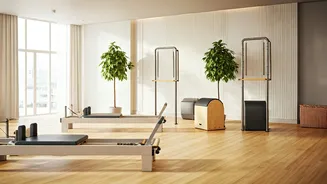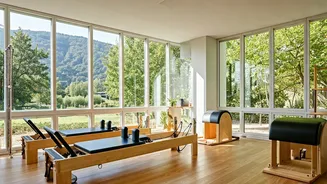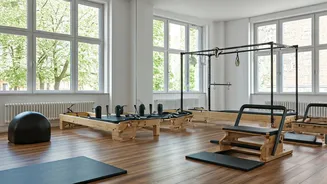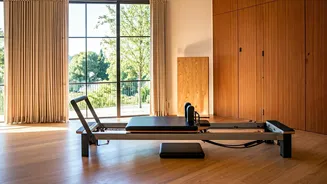Pilates vs Gym
Pilates offers a unique approach to exercise that often surpasses traditional gym workouts. One key benefit of Pilates is its emphasis on core strength.
Pilates exercises focus on strengthening the deep abdominal muscles and lower back, providing better stability and posture. In contrast, many gym routines might focus heavily on isolated muscle groups, potentially neglecting the core. Secondly, Pilates generally promotes improved flexibility and body awareness. Each movement in Pilates is carefully controlled, which can enhance your range of motion and mind-body connection. Gym exercises, especially those involving heavy weights, might not always prioritize these aspects. Furthermore, Pilates is often easier on the joints compared to high-impact gym activities. This makes it a great choice for individuals looking to minimize the risk of injury. Moreover, Pilates can be easily adapted to any fitness level, which makes it welcoming to beginners, while gym workouts sometimes require more advanced understanding. It is also a very efficient use of time, providing a full-body workout that may be completed in a shorter duration than some gym sessions. Choosing Pilates can prove to be a complete and efficient fitness solution.
Pilates vs Walking
While walking is great for overall health, Pilates can offer some advantages. One key benefit of Pilates is the focus on muscular strengthening, which walking lacks. Walking is primarily a cardiovascular activity, that may not fully develop muscle strength, while Pilates incorporates resistance exercises. Another key advantage is the postural improvement. Pilates is particularly effective at strengthening the muscles that support your spine, enhancing posture and reducing back pain. Regular walking does help maintain good posture, it does not specifically target postural muscles as directly as Pilates does. Flexibility is the next benefit of Pilates, which is significantly improved during each exercise, which helps in improved range of motion and preventing stiffness. Regular walking does aid flexibility to some extent, but Pilates generally offers a more comprehensive approach. Pilates workouts are very adaptable and can be easily tailored to individuals with physical limitations. Walking, while generally low-impact, might still be challenging for those with certain conditions. Moreover, Pilates offers a full-body workout with minimal equipment, which makes it perfect for doing at home. While walking is easy and doesn't require any equipment, Pilates can easily be incorporated into your home routine.
Home Pilates Tips
Starting Pilates at home requires minimal equipment but the right approach. Begin by selecting a quiet space with enough room to move freely. A yoga mat is essential for comfort and support. Start by learning basic Pilates exercises such as the hundred, roll-up, and leg circles. You can find many instructional videos online that will show you the correct form and sequence. Next, consistency is key, aim for 20-30 minute sessions, three to five times a week to see results. Remember to breathe properly: Pilates focuses on controlled breathing to coordinate movements and enhance your core engagement. Inhale to prepare and exhale to execute each exercise. Gradually increase the intensity and difficulty of your exercises as you grow stronger. There are many modifications to suit your fitness level. Consider incorporating Pilates props, like resistance bands, small weights, and Pilates rings, to add challenge and variety to your workouts. Listen to your body and avoid pushing yourself too hard, especially in the beginning. Proper form is important to prevent injuries. If possible, consider taking a few online classes or sessions with a certified Pilates instructor. This can provide personalized guidance and ensure you’re doing the exercises correctly. By following these steps and staying committed, you can successfully integrate Pilates into your home fitness routine.
Benefit 1: Core Strength
The cornerstone of Pilates lies in strengthening the core muscles, which include the deep abdominal muscles, the lower back, and the pelvic floor. These muscles act as a support structure for your entire body, enhancing posture and stabilizing the spine. Unlike many gym exercises that may focus on isolated muscle groups, Pilates integrates movements that work your core in every exercise. For example, exercises like the Hundred, Roll-Up, and Plank directly engage the core, building endurance and control. Consistent Pilates practice can improve your posture, reduce back pain, and improve the efficiency of everyday movements. A strong core also plays a crucial role in preventing injuries during other physical activities, making Pilates a great foundation for overall fitness. Pilates exercises emphasize precise movements and controlled breathing, which help to deepen the engagement of the core muscles. The benefit isn't just about looking fit; it's about building a robust and resilient core that enhances overall well-being. So, focusing on core strength is one of the most effective and essential advantages that Pilates offers, contributing to your physical and functional fitness.
Benefit 2: Flexibility
Pilates is renowned for increasing flexibility and range of motion. Pilates exercises are designed to stretch and lengthen muscles, which enhances your body's ability to move freely. Every movement requires you to work through a range of motion, improving both flexibility and mobility. Exercises like spine stretches, side bends, and leg circles are specifically designed to increase flexibility. Increased flexibility can also help to prevent injuries by improving the body's ability to absorb shock and stress. Furthermore, Pilates improves the mind-body connection, helping you become more aware of your body's limits. Through this enhanced awareness, you can push yourself to stretch safely, deepening your flexibility over time. Pilates creates a dynamic balance between strength and flexibility, and the integration of these components helps maintain a healthier and more functional body. Flexibility gained through Pilates can enhance athletic performance and improve the ease of movement in daily activities, making it an essential element for overall well-being.
Benefit 3: Posture Improvement
Pilates is exceptional for improving posture by targeting the deep postural muscles. These are the muscles that support the spine and keep your body aligned. With Pilates, you consciously work to strengthen these muscles, leading to better posture in daily life. Most of the exercises in Pilates promote correct spinal alignment. Movements like the Pilates Swan and swimming exercises strengthen the back and core muscles, which contributes to a more upright posture. Improved posture goes beyond aesthetics; it can significantly reduce back pain and shoulder discomfort. Correct posture also improves breathing and digestion, enhancing overall well-being. Regular practice can help to retrain your body to maintain a more balanced and aligned posture even when you're not exercising. This focus on postural alignment is unique, providing long-term benefits that extend far beyond the Pilates mat. As you improve your posture, you'll likely feel more confident and experience fewer aches and pains.
Benefit 4: Low-Impact Exercise
Pilates is a low-impact form of exercise, which makes it safe for people of all ages and fitness levels. Unlike high-impact activities such as running or jumping, Pilates places minimal stress on your joints. This makes it an ideal option for those with joint pain or other physical limitations. It is also beneficial for people with conditions like arthritis or osteoporosis. Because Pilates is a low-impact exercise, it reduces the risk of injury. This allows you to work towards your fitness goals without worrying about hurting your joints. Pilates offers a controlled and gentle approach to exercise. Moreover, Pilates can easily be modified to suit individual needs. Beginners and those with health concerns can adapt exercises. The focus is always on controlled movements and proper form. Choosing Pilates can be an effective way to improve fitness while prioritizing joint health, making it a valuable addition to any exercise routine.
Benefit 5: Mind-Body Connection
Pilates emphasizes the connection between your mind and body. The deliberate, controlled movements of Pilates require you to focus on your body. This awareness improves your mind-body connection. Each exercise requires concentration on precise movements and breathing. This can improve your overall mental clarity. Through this process, you learn to coordinate your movements. Increased body awareness can positively impact various aspects of your life. This includes posture, balance, and general coordination. Pilates helps you understand how your body functions and reacts to different movements. Regular Pilates practice can lead to a sense of calm and well-being. This is due to the focus on breath control and mindful movement. This conscious connection enhances your body awareness and creates a more harmonious relationship between your physical and mental states.











